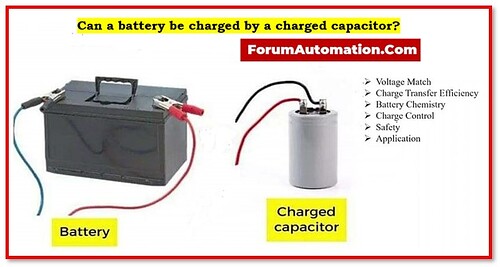It is possible to charge a battery using a charged capacitor, although this usually requires more steps than simply attaching the capacitor to the battery. To ensure secure and effective charging, a circuit that regulates the movement of charge from the capacitor to the battery is required.
Below is an overall description of how this procedure might function:
- Control circuitry: To handle the charging process, will need a control circuit. Diodes, resistors, & voltage regulators are a few examples of the parts that can be used in this circuit to regulate the voltage and current flow during charging.
- Voltage Matching: Check to see if the voltage of charged capacitor matches that the battery needs. The battery could be harmed if the voltage on the capacitor is too high.
- Current Limiting: Implement a current-limiting system to stop excessive current from flowing into the battery, which could cause overcharging and result in battery damage.
- Voltage Regulation: To keep the battery’s charging voltage constant, use voltage regulation. This assists in avoiding overcharging, that can be detrimental to some battery types.
- Protection: Include protections against conditions such as overcharging, over discharging, and overcurrent that can harm the battery or potentially provide a safety risk.
- Controlled Discharge: The capacitor should be disconnected from the circuit once the battery has finished charging to stop the battery from discharging and returning to it. This can happen if the voltage across the capacitor falls below the battery voltage.
- Monitoring: While the battery is being charged, it’s necessary to keep track on its condition. To make sure the battery is charging safely & effectively, this may involve taking measurements of voltage, current, and temperature.
- Safety Considerations: Be known of the chemistry and special features of the battery you are charging. For example, lead-acid and lithium-ion batteries have different charging requirements & safety considerations.
In conclusion, although a charged capacitor can be utilized for charging a battery, rigorous control and regulation are necessary to provide a secure and effective charge. Without the proper circuitry, utilizing the capacitor alone can result in overcharging, which could be dangerous and detrimental to the battery. As a result, it’s essential to develop and install a charging circuit that satisfies the unique needs of the battery that need to charge.
You can also follow us on AutomationForum.co, Facebook and Linkedin to receive daily Instrumentation updates.
You can also follow us on ForumElectrical.com , Facebook and Linkedin to receive daily Electrical updates.
